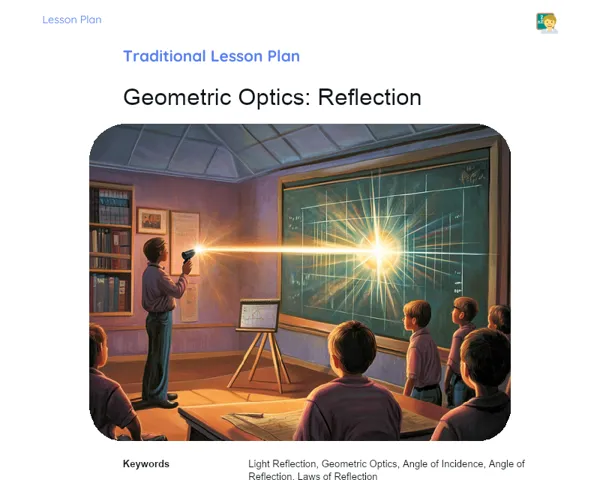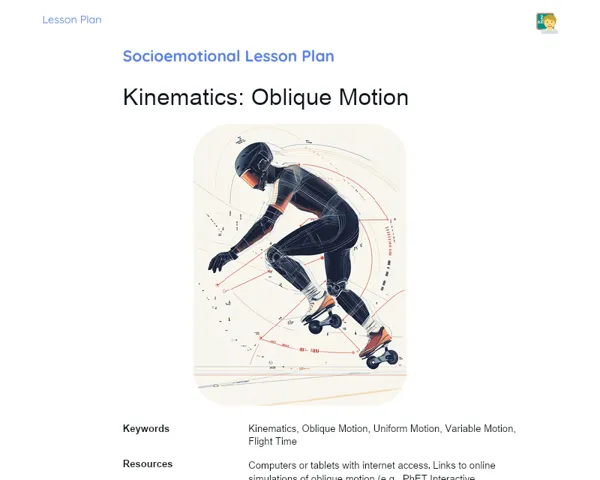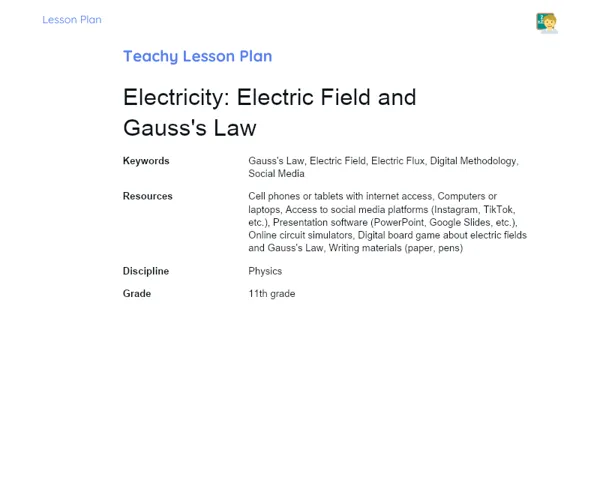Lesson Plan Teknis | Kinematics: Relationship between Speeds in Circular Motions
| Palavras Chave | Kinematics, Angular Velocity, Linear Velocity, Circular Motion, v=ωR, Maker Activity, Practical Challenge, Problem Solving, Real Applications, Automotive Engineering, Robotics, Aerospace Technology |
| Materiais Necessários | Cardboard, Popsicle Sticks, Hot Glue, Wires, Batteries, Small Electric Motor, Cutting Tools (scissors or utility knives), Ruler, Stopwatch or clock with seconds, Calculators |
Objective
Duration: 15 - 20 minutes
The main goal of this stage is to help students grasp the theoretical basis for converting angular velocities into linear velocities. This is essential for developing practical skills that will be used in hands-on activities and challenges throughout the lesson. Furthermore, this understanding will help students connect their learning to real-world contexts, particularly in fields such as engineering, robotics, and the automotive industry.
Objective Utama:
1. Understand the relationship between angular velocity and linear velocity.
2. Apply the formula v=ωR in practical situations related to circular motion.
Objective Sampingan:
- Recognise the importance of kinematics in technology advancement.
- Enhance problem-solving skills by applying theoretical concepts in practical experiments.
Introduction
Duration: 15 - 20 minutes
The aim of this segment is to ensure students understand the theoretical underpinning required to translate angular velocities into linear velocities. This is key for enhancing practical skills that will be employed in experimental tasks and challenges during the lesson, and it is essential for drawing connections with real-world scenarios in the job market, where kinematics is frequently applied.
Curiosities and Market Connection
Did you know that angular velocity plays a vital role in automotive engineering? The functioning of engines and transmission systems relies heavily on understanding this relationship. In robots, for instance, kinematics is fundamental for programming accurate movements of robotic arms. In the aerospace sector, engineers use these principles to calculate the spin of turbines and propellers in aircraft and helicopters.
Contextualization
Kinematics is a branch of physics that looks into the motions of objects without focusing on the forces that cause them. A key concept in kinematics is the relationship between angular velocity and linear velocity, especially in circular motion. Consider the wheel of a bicycle: understanding how its rotational speed (angular velocity) translates to how fast the bicycle moves forward (linear velocity) is crucial not only for cyclists but also for engineers and bicycle designers.
Initial Activity
Show a short video (2-3 minutes) of a Ferris wheel in action and ask students: 'How does the speed at which the Ferris wheel turns relate to the speed of the seats where passengers sit?' This will encourage curiosity and set the stage for discussions on the relationship between angular and linear velocities.
Development
Duration: 55 - 60 minutes
This stage's aim is to let students apply theoretical concepts of angular and linear velocity through practical activities, leading to a deeper and more tangible understanding of the subject. Additionally, by tackling practical challenges, students will develop their problem-solving and teamwork skills, equipping them for real-life situations they may face in the job market.
Topics
1. Understanding angular velocity
2. Understanding linear velocity
3. The relationship between angular and linear velocity: v=ωR
4. Practical uses of the formula in various contexts
Thoughts on the Subject
Encourage students to think critically about how the connection between angular and linear velocity might be applied in different job sectors, such as automotive engineering, robotics, and aerospace technology. Prompt them to consider how this relationship could impact the design and effectiveness of machines and devices that rely on circular motion.
Mini Challenge
Maker Challenge: Create a Mini Carousel
In this activity, students will build a mini carousel using simple materials such as cardboard, popsicle sticks, and a small electric motor. The goal is to apply the formula v=ωR to convert the motor's angular velocity into the linear speed of the carousel's seats.
1. Organise students into groups of 4 to 5.
2. Provide the necessary materials: cardboard, popsicle sticks, hot glue, wires, batteries, and a small electric motor.
3. Instruct groups to draw and cut a cardboard circle for the carousel's base.
4. Ask them to attach popsicle sticks to the cardboard base to represent carousel seats.
5. Guide students to connect the electric motor to the central point of the carousel base, ensuring it can rotate freely.
6. Have groups turn on the motor and measure the angular velocity (ω) of the carousel in revolutions per minute (RPM).
7. Instruct students to convert the angular velocity to linear velocity (v) using the formula v=ωR, where R is the radius of the carousel's base.
8. Encourage groups to present their findings and explain how they calculated the linear velocity of the seats.
Practically apply the formula v=ωR and understand how angular velocity is related to linear velocity in a circular motion system.
**Duration: 40 - 50 minutes
Evaluation Exercises
1. Calculate the linear velocity of a point on a wheel with a radius of 0.5 meters rotating at 30 RPM.
2. A car is turning with a radius of 20 meters at an angular velocity of 2 rad/s. What is the linear velocity of the car?
3. Explain how a motor's angular velocity can affect a vehicle's linear velocity in its transmission system.
4. Describe a real-life scenario where converting angular velocity to linear velocity is crucial.
Conclusion
Duration: 10 - 15 minutes
This stage aims to solidify the knowledge acquired during the lesson, bridging theory with practice and underscoring the relevance of learned concepts to the job market. Additionally, discussions and reflections will enhance a deeper and more contextual learning experience, preparing students to apply this knowledge in practical situations.
Discussion
Encourage a discussion about the connection between angular and linear velocity. Ask students how they applied the formula v=ωR during the maker challenge and what insights they gained from this hands-on experience. Prompt them to reflect on how these concepts can be relevant in real-world job contexts, such as in automotive engineering, robotics, and aerospace technology. Inquire how an understanding of this relationship can influence the design and efficiency of machines and devices employing circular motion.
Summary
Summarise the key topics addressed in the lesson: the understanding of angular and linear velocity, their relationship through the formula v=ωR, and their practical implications. Highlight how the lesson successfully linked theory with practice through the maker challenge and the fixation exercises. Stress the importance of grasping this relationship to address real-world challenges and foster innovative technologies.
Closing
Explain to students that the knowledge gained about the connection between angular and linear velocity is fundamental not only for studying physics but also for various career opportunities. Reinforce that this understanding is crucial for developing more efficient and innovative technologies. Encourage them to keep exploring and applying these concepts in their future studies and careers.



